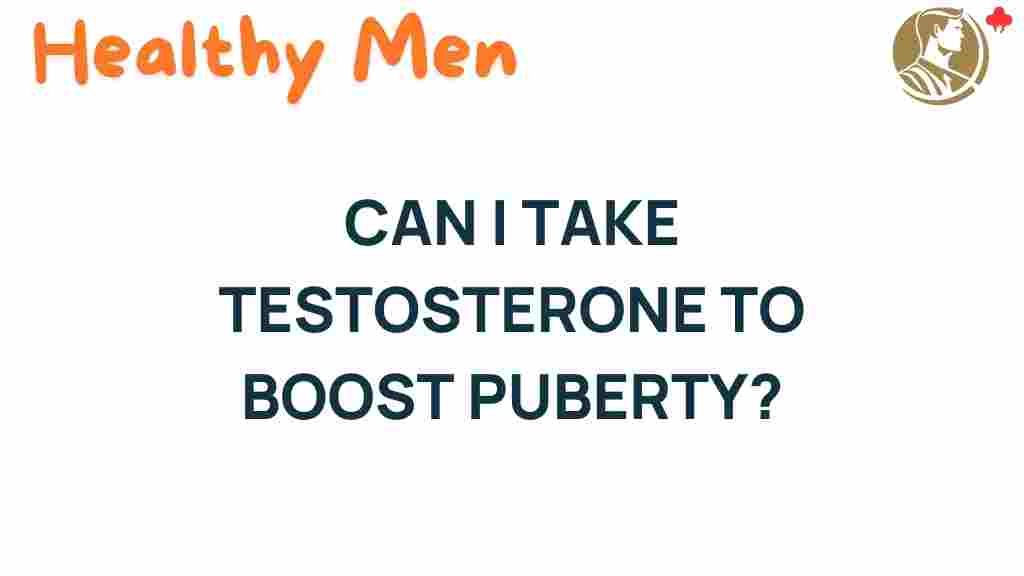Unlocking Puberty: The Role of Testosterone Therapy in Adolescents
Puberty is a critical stage in human development that marks the transition from childhood to adulthood. It is characterized by a series of physical, emotional, and hormonal changes that prepare the body for reproductive maturity. Among the various hormones that play a significant role in this process, testosterone is perhaps the most well-known, particularly for its impact on adolescent males. However, testosterone therapy is not limited to boys; it can also be beneficial for girls experiencing hormonal imbalances. This article will explore the role of testosterone therapy in adolescents, focusing on its importance in puberty, the intricacies of hormone therapy, and the guidance required for effective treatment.
Understanding Testosterone and Puberty
Testosterone is an essential hormone produced primarily in the testes in males and in the ovaries and adrenal glands in females. It plays a vital role in various bodily functions, including:
- Regulating muscle mass and strength
- Promoting bone density
- Influencing mood and energy levels
- Facilitating sexual development and function
During puberty, testosterone levels surge, leading to physical changes such as growth spurts, the development of secondary sexual characteristics (like facial hair in boys), and an increase in libido. However, not all adolescents experience these changes as expected, which can lead to various health issues.
The Importance of Hormone Therapy
For some adolescents, testosterone therapy may be necessary to address hormonal deficiencies or disorders. Conditions that may warrant hormone therapy include:
- Delayed puberty: When an adolescent has not begun developing secondary sexual characteristics by the expected age.
- Hypogonadism: A condition where the body does not produce enough testosterone.
- Gender dysphoria: A condition where an individual’s gender identity does not align with their biological sex, leading to a desire for physical changes through hormone therapy.
It is crucial to approach testosterone therapy with careful medical guidance. A healthcare provider specializing in endocrinology can assess the adolescent’s specific needs and determine the best course of treatment.
Step-by-Step Process for Testosterone Therapy
Initiating testosterone therapy involves several steps, each tailored to the adolescent’s unique circumstances. Here’s a breakdown of the process:
1. Medical Evaluation
The first step is a comprehensive medical evaluation, which includes:
- A thorough medical history to identify any underlying health issues.
- Physical examinations to assess growth and development.
- Blood tests to measure current testosterone levels and other relevant hormones.
These evaluations help healthcare providers understand the adolescent’s health status and determine whether testosterone therapy is appropriate.
2. Discussing Treatment Options
After the initial evaluation, the healthcare provider will discuss various treatment options available for testosterone therapy, including:
- Injections: Testosterone can be administered via intramuscular injections, typically every one to two weeks.
- Patches: Transdermal patches deliver a consistent dose of testosterone throughout the day.
- Gels: Topical gels are applied daily to the skin, allowing testosterone to be absorbed directly into the bloodstream.
The choice of treatment depends on factors such as the adolescent’s lifestyle, preferences, and specific medical needs.
3. Establishing a Treatment Plan
Once a treatment option is selected, the healthcare provider will establish a detailed treatment plan, which may include:
- Dosage recommendations based on the adolescent’s age, weight, and testosterone levels.
- Scheduled follow-up appointments to monitor progress and make necessary adjustments.
- Regular blood tests to track hormone levels and assess the effectiveness of the therapy.
It is essential for parents and guardians to be involved in this planning process to ensure the adolescent receives the best possible care.
4. Monitoring and Adjusting Treatment
Regular monitoring is crucial during testosterone therapy. Parents, guardians, and healthcare providers must stay vigilant for any side effects or complications, which may include:
- Acne or oily skin
- Increased aggression or mood swings
- Changes in libido
- Potential cardiovascular risks
Based on these observations, the healthcare provider may adjust the dosage or change the treatment method. Continuous communication between the adolescent and their medical team is vital to ensure optimal outcomes.
Troubleshooting Common Concerns
As with any medical treatment, there may be challenges during testosterone therapy. Here are some common concerns and potential solutions:
1. Side Effects
Some adolescents may experience side effects from testosterone therapy. Addressing these concerns promptly is crucial. Parents should encourage open communication about any changes the adolescent may be experiencing. If side effects are significant, consult the healthcare provider to adjust the treatment plan.
2. Emotional Changes
Hormonal changes can lead to emotional fluctuations. Adolescents undergoing testosterone therapy may experience mood swings or increased irritability. Support from family, friends, and mental health professionals can be beneficial during this adjustment period.
3. Social Stigma
Adolescents dealing with hormonal issues may face social stigma, particularly if they are undergoing gender transition. It is important to foster an environment of acceptance and understanding. Open discussions about puberty, hormone therapy, and the challenges associated with them can help reduce stigma and promote youth wellness.
Conclusion
Testosterone therapy can play a critical role in supporting adolescents during puberty, especially for those facing hormonal imbalances or delays in development. With proper medical guidance, careful monitoring, and a supportive environment, many adolescents can successfully navigate this challenging phase of life. If you or someone you know is considering testosterone therapy, consult a qualified healthcare provider specializing in adolescent health and endocrinology. This will ensure that all treatment options are explored, and the best possible care is provided for healthy growth and development.
For further information on adolescent health and hormone therapy, check out this resource. Remember, taking a proactive approach to health during puberty is essential for long-term wellness.
This article is in the category Conditions and created by healthymen Team
